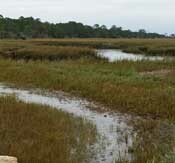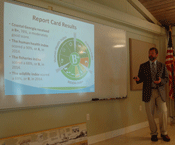Coastal Georgia's ecosystem health report card

Alex Fries and Caroline Donovan traveled to Brunswick, Georgia to facilitate a workshop on a coastal Georgia report card for the Georgia Department of Natural Resources'
Coastal Resources Division. The coastal Georgia ecosystem has an extensive salt marsh system that stretches from Savannah in the north to the Georgia-Florida border in the south. The shape of Georgia contributes to the large tidal range (average 6 feet, spring tides as high as 10 feet), which feeds the salt marshes. Barrier islands speckle the coastline, as well, protecting the marshes from storms and sea level rise. These natural ecosystems have led to abundant fish, shrimp, and crustacean populations. The few threats and pressures include contaminants from factories and Superfund sites. The report card will be released in summertime 2015.
 Alex Fries and Caroline Donovan traveled to Brunswick, Georgia to facilitate a workshop on a coastal Georgia report card for the Georgia Department of Natural Resources' Coastal Resources Division. The coastal Georgia ecosystem has an extensive salt marsh system that stretches from Savannah in the north to the Georgia-Florida border in the south. The shape of Georgia contributes to the large tidal range (average 6 feet, spring tides as high as 10 feet), which feeds the salt marshes. Barrier islands speckle the coastline, as well, protecting the marshes from storms and sea level rise. These natural ecosystems have led to abundant fish, shrimp, and crustacean populations. The few threats and pressures include contaminants from factories and Superfund sites. The report card will be released in summertime 2015.
Alex Fries and Caroline Donovan traveled to Brunswick, Georgia to facilitate a workshop on a coastal Georgia report card for the Georgia Department of Natural Resources' Coastal Resources Division. The coastal Georgia ecosystem has an extensive salt marsh system that stretches from Savannah in the north to the Georgia-Florida border in the south. The shape of Georgia contributes to the large tidal range (average 6 feet, spring tides as high as 10 feet), which feeds the salt marshes. Barrier islands speckle the coastline, as well, protecting the marshes from storms and sea level rise. These natural ecosystems have led to abundant fish, shrimp, and crustacean populations. The few threats and pressures include contaminants from factories and Superfund sites. The report card will be released in summertime 2015.
 The Coastal Georgia Ecosystem Report Card was released November 13th, in Brunswick, GA. Heath Kelsey and Alexandra Fries revealed and discussed the report card grades during a two-part release event for both the press and technical audiences. Developed by the Georgia Department of Natural Resources Coastal Resources Division and IAN, this report card provides a transparent assessment of Coastal Georgia. The report card includes twelve indicators in total: three human health indicators, three fisheries indicators, and six wildlife indicators. In 2014, the overall grade for Coastal Georgia was 76%, a B+. This means the coast is in moderately good health. For further details, visit the report card page here.
The Coastal Georgia Ecosystem Report Card was released November 13th, in Brunswick, GA. Heath Kelsey and Alexandra Fries revealed and discussed the report card grades during a two-part release event for both the press and technical audiences. Developed by the Georgia Department of Natural Resources Coastal Resources Division and IAN, this report card provides a transparent assessment of Coastal Georgia. The report card includes twelve indicators in total: three human health indicators, three fisheries indicators, and six wildlife indicators. In 2014, the overall grade for Coastal Georgia was 76%, a B+. This means the coast is in moderately good health. For further details, visit the report card page here.